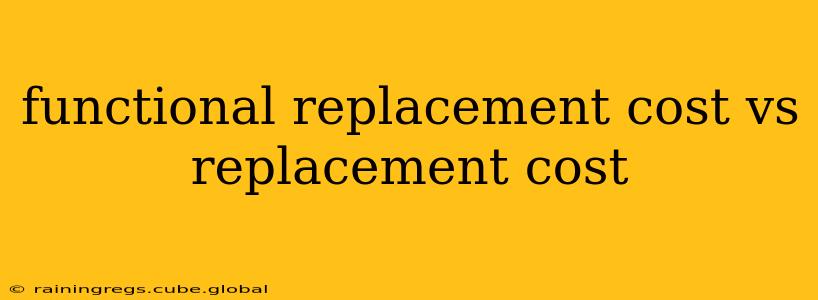Determining the value of an asset, whether it's a building, equipment, or even intellectual property, is crucial for various purposes, including insurance, accounting, and tax assessments. Two key methods for calculating this value are replacement cost and functional replacement cost. While both aim to establish the cost of replacing an asset, they differ significantly in their approach, leading to potentially vastly different valuations. Understanding these differences is essential for making informed decisions.
What is Replacement Cost?
Replacement cost refers to the current cost of replacing an asset with a new asset of like kind and quality. This means finding a comparable asset in the current market and determining its price. It doesn't consider any depreciation or obsolescence of the original asset. The focus is solely on the cost of acquiring an identical or nearly identical replacement today.
Example: If your 10-year-old manufacturing machine originally cost $100,000 but a comparable new machine currently costs $150,000, the replacement cost is $150,000, regardless of the machine's age or condition.
What is Functional Replacement Cost?
Functional replacement cost, on the other hand, focuses on the cost of replacing an asset with a new asset that provides the same functionality, even if it's not identical in terms of make, model, or features. This approach acknowledges that technological advancements often allow for more efficient or effective alternatives to older assets. The goal is to replace the function, not necessarily the specific item.
Example: Using the same manufacturing machine example, a functionally equivalent, newer machine might achieve the same output with different technology, perhaps costing only $120,000. This $120,000 would represent the functional replacement cost, as it replicates the original machine's functionality at a lower price point.
Functional Replacement Cost vs. Replacement Cost: Key Differences Summarized
| Feature | Replacement Cost | Functional Replacement Cost |
|---|---|---|
| Focus | Identical replacement | Functional equivalence |
| Considerations | Current market price of a like-kind asset | Cost of a new asset providing the same function |
| Depreciation | Not considered | Implicitly considered through the use of alternatives |
| Technological Advancements | Not considered | Explicitly considered |
| Value | Typically higher | Typically lower |
Which Method is Best?
The best method depends on the context.
-
Insurance: Replacement cost is often preferred by insurers for physical assets as it guarantees the ability to replace the damaged asset with an identical one.
-
Accounting: Functional replacement cost might be more appropriate for accounting purposes, as it reflects the current cost of maintaining the same level of operational capacity. This can lead to a more realistic assessment of the company's assets and liabilities.
-
Tax Assessments: The chosen method might vary depending on specific tax regulations and the nature of the asset being assessed.
Frequently Asked Questions
What are the factors influencing functional replacement cost?
Several factors influence functional replacement cost, including technological advancements, material costs, labor costs, and overall market conditions. The availability of more efficient alternatives significantly impacts the final cost.
How is depreciation accounted for in functional replacement cost?
Depreciation isn't explicitly calculated in functional replacement cost. However, it's implicitly considered because the cost reflects the current market value of a functionally equivalent, but potentially newer and more efficient, asset. The newer asset often incorporates improvements that offset the cost of depreciation of the old asset.
Can I use both methods simultaneously?
While you can calculate both replacement costs, using both simultaneously may lead to confusion. The selection of the most appropriate method should depend on the purpose of the valuation. Clearly stating the method used and its rationale is crucial for transparency.
Which method is more commonly used for insurance purposes?
Replacement cost is more commonly used for insurance purposes, ensuring that policyholders receive enough to replace their damaged assets with like-kind and quality items, regardless of technological advances or depreciation.
By understanding the nuances of replacement cost and functional replacement cost, you can make informed decisions regarding asset valuation for various financial and operational purposes. Choosing the right method ensures accurate assessment and appropriate planning for the future.
